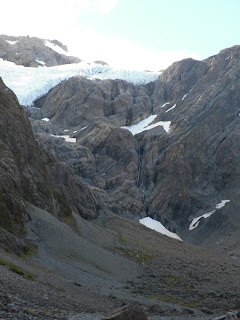
The next morning the group awoke at Crow Hut and quickly packed. Though the day was expected to be warm, the sun had not yet risen above the surrounding mountains. Dew covered the grass and it was cold as the three gathered their belongings and set out, stopping for one final photo.
This day's hike would seem simple compared to the steep climb and descent they faced the previous day. It was flat as they weaved their way down the path, stepping in and out of the forest as they went. To the left was the glacial river, guiding them on this day. The river would lead back to the road, back to civilization. Back to... school.

Eventually the sun rose high enough to peak over the tops of the mountains. As the temperature increased, it was as if the seasons had changed within a few short minutes.

The path through the forest eventually came to an end, leaving only the riverbank to walk along. Stopping to refill their bottles with the crisp water every so often, the relaxed pace on this day was a nice change for the three. However, there were several setbacks waiting ahead.

Along the river there was no clear path. The three simply walked along its banks and wondered when they would reach the end. As simple as this may seem, problems arose when obstructions would appear, forcing the group to attempt to cross to the opposite side.
The water was deceptively quick, but it was still easily passable. Scouting out the best locations, the three were often able to avoid getting wet by hopping on the rocks that were strewn about. But not always.
Coming up to one crossing, it became clear that there was no simple way to cross. After considering the situation for several minutes, a plan was formed. All three would remove their shoes and wade across, as the river was only two or three feet deep. Seemingly simple, things quickly got complicated.
One member of the group decided that it would be best to remove his shoes and then toss them onto the opposite bank, leaving his hands free to navigate the swift current.
He removed the first shoe and tossed it onto the other side. Success.
He removed his second shoe and threw it in a similar fashion. Immediately upon releasing this second shoe, he realized what was about to happen.
Holding on to the shoe for a second too long, it had popped straight up into the air. He watched helplessly as it remained suspended in the sky for a moment, and then...
Dropped into the middle of the river.
As the current was strong, the shoe was quickly swept away, leaving its owner standing barefooted and on the wrong side of the river.
The consequences of this tremendous screw up were clear; the group still had several miles to go, walking across large rocks. This could be difficult with shoes, but without...
Realizing what was happening, one of the travelers that had already made it across sprung into action. Dropping his bag, he sprinted roughly 100 yards down stream, desperately trying to get ahead of the wayward shoe. Eyes scanning frantically, he wasn't sure if he would be able to locate it in time.
But he did! Walking triumphantly back to the point where they all crossed, the shoe was returned to a very sheepish owner.

The remainder of river crossings were done so without the removal of shoes.
Soon after this, the scenery changed. The valley opened up considerably, leaving the three to wander through a vast flatland filled with nothing but rocks.

This is the environment through which they walked in silence, knowing that the end of their journey was rapidly approaching and having mixed emotions about it. The two days had been difficult yet exhilarating, with breathtaking views and a healthy amount of banter and laughter.
But now, with the emergence from the sea of rocks, it was all about to end. Crossing an enormous green field in their home stretch, each group member allowed themselves to get lost in their own thoughts.

Finally reaching the road, the three sat down and had lunch. It was still hours before they needed to be back at school, and though they were just under 150 kilometers away, there was little urgency in their words or actions. Instead, they sat in the sun and ate.
Finishing their meal, they looked around and decided to make their move. Though one adventure had ended, another was just now beginning.
Standing slowly, the three turned and directed their attention down the road, off into the horizon.












































 Not trying to go overboard with the technical lingo, the following are the general rules for a 2o/20 cricket match, such as the one played on this night:
Not trying to go overboard with the technical lingo, the following are the general rules for a 2o/20 cricket match, such as the one played on this night:



 Putting up 116 of New Zealand's 214 runs, McCullum (42) teed off on Australia's bowlers all night, including the most impressive shot of the night, a 6 that he seemed to pluck off of his shoes.
Putting up 116 of New Zealand's 214 runs, McCullum (42) teed off on Australia's bowlers all night, including the most impressive shot of the night, a 6 that he seemed to pluck off of his shoes.
 The stands, which had been rather unruly for the vast majority of the contest, now grew noticeably tenser. The victory which the mob had been confident in only moments before now seemed to be slipping away, and every ball became increasingly critical.
The stands, which had been rather unruly for the vast majority of the contest, now grew noticeably tenser. The victory which the mob had been confident in only moments before now seemed to be slipping away, and every ball became increasingly critical.
